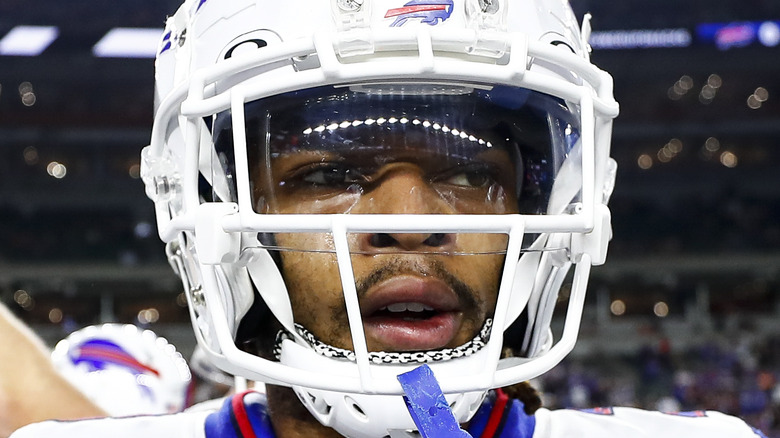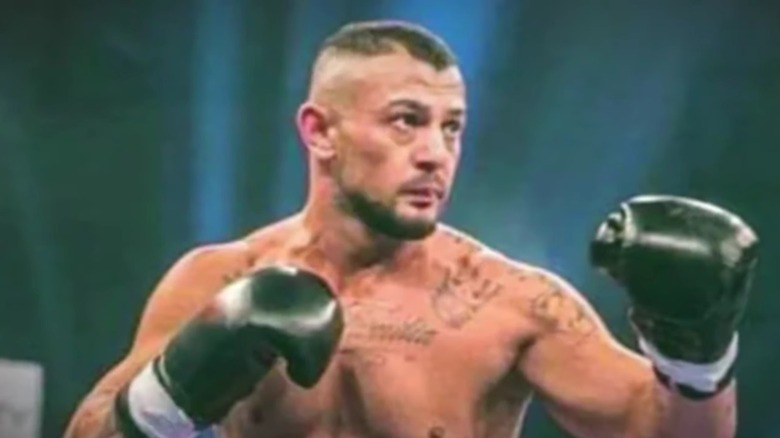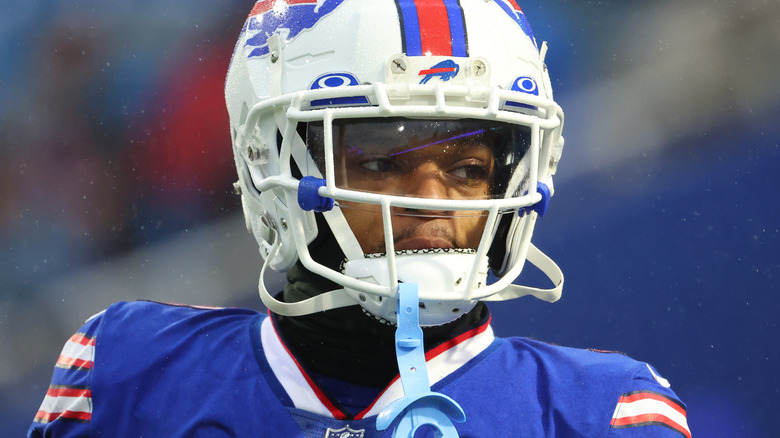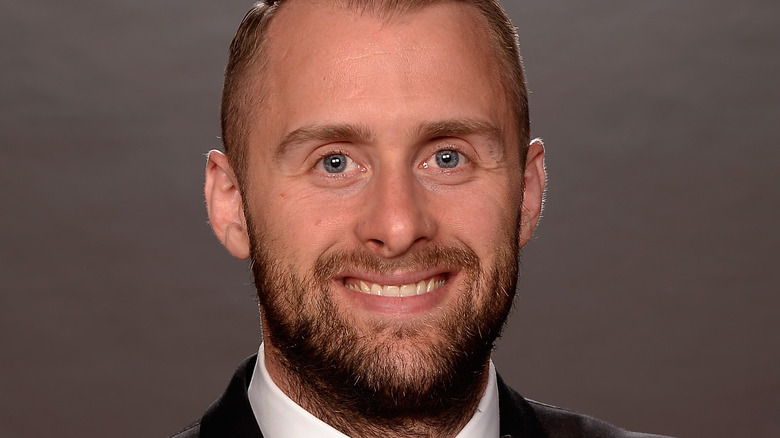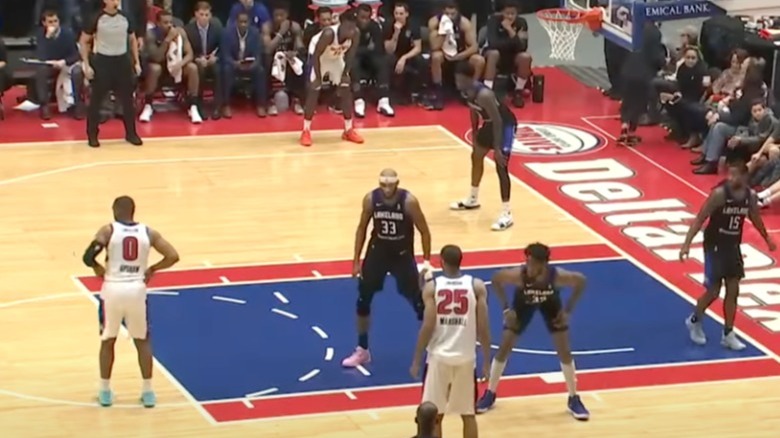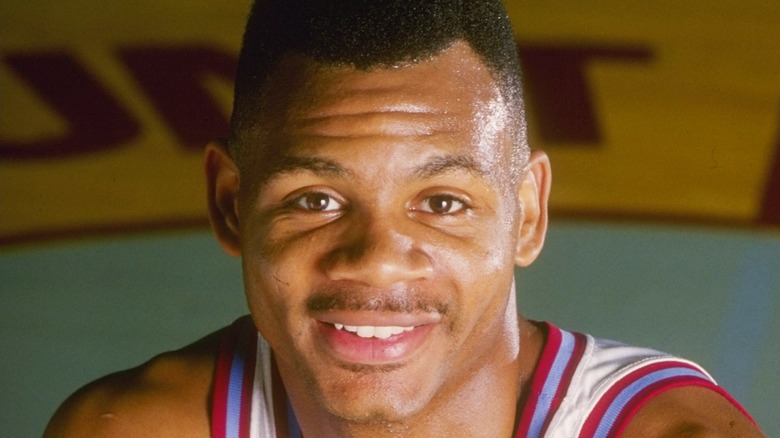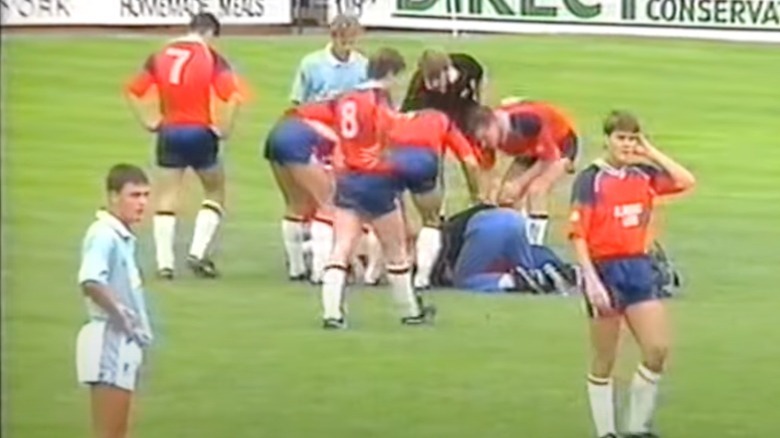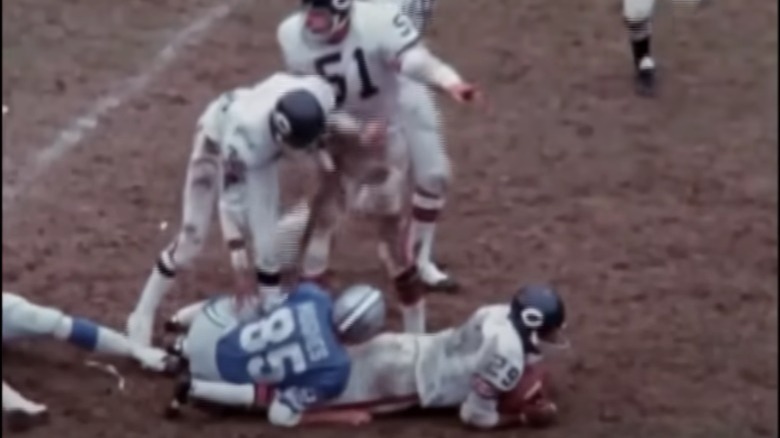Athletes Who've Suffered Cardiac Arrest While Competing
For all sport can teach us about teamwork, perseverance, and dedication, it also has plenty to teach us about pain — both the kind you can play through, and the kind you can't. For every athlete who has managed to complete their careers relatively free of injury or health issues, there are scores more who have suffered serious, even life-changing, mishaps on their chosen fields of play. Sure, you can make the argument that pro athletes are paid millions of dollars to put their safety on the line while you toil away at your far-less-lucrative-yet-still-super-dangerous job as a sanitation worker (via Business Insider), but at least you don't have to collect trash while J.J. Watt is trying to take your head off.
From hockey to football (both kinds) to boxing to distance running, athletes regularly engage in the kind of intense physical activity that would have most of us weeping like toddlers after five minutes, and even the most conditioned of bodies can be pushed beyond their limits to catastrophic effect. The athletes we'll be looking at today — the ones who are still with us, that is — know this all too well, as they all suffered that most terrifying and dangerous of medical maladies, cardiac arrest, right in the middle of competition.
Musa Yamak
Turkish-born German boxer Musa Yamak could hardly have had a more promising start to his career. According to RT, the pugilist turned pro in 2017, and his first eight bouts went pretty well; he amassed a record of 8-0, with every win coming by knockout, and in 2021 he won the World Boxing Federation light heavyweight international title. In May 2022, he took to the ring to face Ugandan opponent Hamza Wandera in a matchup that probably should have been a walk in the park. Instead, it turned into a nightmare.
German news outlet Bild reports that Yamak didn't appear to have taken any major hits in the first two rounds and exited his corner for the third — and then, he simply went down and didn't get back up. As horrified fans looked on, he was worked on by paramedics, then taken to the hospital, where he was pronounced dead. The boxer's heart had given out at only 38 years old, shocking the boxing world and robbing Yamak of what was shaping up to be a bright future.
Damar Hamlin
Everybody knows that NFL football is a violent sport, but the play that very nearly ended the life of Buffalo Bills safety Damar Hamlin didn't exactly look like one that should have resulted in serious injury, much less a medical emergency. In the first quarter of a Monday night game against the Cincinnati Bengals on January 2, 2023, Hamlin tackled receiver Tee Higgins, absorbing a reasonably hard shot to the chest in the process. Hamlin stood up, took a couple of steps, and collapsed — and as Bills medical staff worked on him, it became clear that something was very wrong (via The New York Times).
Hamlin was transported from the field in an ambulance, and it was later reported that he had likely been struck by a condition known as commotio cordis, in which an impact to the chest delivered in a very specific spot at a key moment in the cardiac cycle can cause the heart to simply stop, per NPR. After a week recovering at the University of Cincinnati Medical Center, Hamlin was discharged to go home to Buffalo, where he was promptly checked back in to the hospital for further monitoring (via CNN). As of this writing, his recovery appears to be coming along nicely; nine days after the incident, the Bills reported via Twitter that Hamlin had been released from Buffalo General Medical Center. But his shocking close call with death, broadcast live on national television, will long linger in the minds of NFL fans.
Chris Pronger
If there's any pro sport that is possibly even more brutal than football, it's hockey. From broken bones to broken faces to sliced-open necks, hockey has produced some of the most devastating injuries in sports history — but of all the injury trophies to be handed out, the one for "Took professional-grade slapshot directly to the ticker" can be claimed by just one man.
This would be defenseman Chris Pronger, who as a member of the St. Louis Blues suffered that very injury during a 1998 playoff game, according to the Toronto Star. "I went out to block a shot and I got a slap shot directly in the heart," Pronger remembered. "The next thing you know, I woke up and was staring at the banners at the Joe Louis Arena, turned to the side and saw players crying." After being carted off the ice on a stretcher and rushed to the hospital, it was determined that he had experienced an episode of commotio cordis. As one might imagine, watching Damar Hamlin go down brought back some unpleasant memories for Pronger, who expressed concern for Hamlin and his family while praising the Bills' medical staff for recognizing the seriousness of the situation. Pronger made a full recovery and continued his career, even winning a Stanley Cup with the Anaheim Ducks in 2007, according to the NHL's website.
Jay Bouwmeester
Oddly, a 2020 meeting between the St. Louis Blues and the Anaheim Ducks was the setting for another scary, albeit slightly less dramatic, incident involving a cardiac episode. As he was sitting on the bench, Blues defenseman Jay Bouwmeester suddenly began feeling a little off — and then, a lot off. "It all just came pretty suddenly," Bouwmeester would later say (via People). "Everything up to that point was normal. I hadn't been sick or had much going on. It was completely out of the blue."
"It" was a slight case of cardiac arrest, and while it was obviously a frightening circumstance, Bouwmeester had nothing but gratitude for the Blues' medical staff, saying that the event took place "in the absolute best place that it could happen" and crediting the team's doctors with saving his life with their quick deployment of the defibrillator. Bouwmeester was placed on injured reserve for the remainder of the season, after which he "quietly" retired, according to The Athletic. The proud owner of a new cardioverter defibrillator implanted in his chest, Bouwmeester is now living a relatively normal life — and understandably, after his distinguished 17-year NHL career that included a Stanley Cup win, he never considered returning to the ice. "I knew I was done essentially when it happened, to be quite honest," he said.
Rich Peverley
Jay Bouwmeester was not the first NHL player to suffer a heart attack while waiting on the bench to return to the ice. In 2014, the Dallas Stars' Rich Peverley collapsed while sitting out, prompting the team's medical staff to immediately begin chest compressions before applying the defibrillator, per Bleacher Report. Their quick action almost certainly saved Peverley's life — but in his case, the incident came with a bit of ominous foreshadowing.
According to ESPN, about a week before the game, Peverley experienced an episode of atrial fibrillation (commonly known as AFib), during which he was struck with a fluttering, irregular heartbeat. The condition resolved, and team doctors had been closely monitoring Peverley, who had played in two games since the AFib incident and was displaying no further physical symptoms that would have raised any red flags. Despite attempting to mount a comeback after his collapse, Peverley was ultimately advised against it by his doctors — and according to the NHL's website, he retired in 2015, joining the Stars' front office to help develop new players.
Meghan Roth
While pretty much all sports are physically demanding, few athletes are possessed of more robust endurance than distance runners. That's why it was particularly shocking when, in 2021, elite runner Meghan Roth suddenly collapsed during the eighth mile of the Boston Marathon, according to CBS News. "It happened in seconds," Roth remembered. "I passed out. I don't remember hitting the ground." Fortunately for her, acquaintance and fellow runner Nick Haney — who happened to hold down a day job as a firefighter — was also taking part in the marathon, and immediately sprang into action. "The fact that I knew who this person was made it a lot more real," Haney said. "At work you're not used to going on people we know or care about."
Per The Washington Post, Haney was joined by spectator and retired nurse Marie Rogers and others, all of whom took turns administering CPR until an ambulance made its way to the scene. Roth was rushed to the hospital, where she too was fitted with an implantable cardioverter defibrillator and discharged just four days after the heart attack. Going down in the middle of the Boston Marathon certainly makes for a dramatic story — but for a distance runner, accustomed to training on long, empty stretches of road in the middle of nowhere, it could hardly have happened in a more fortunate setting.
Zeke Upshaw
A top-rated high school player in Illinois, Zeke Upshaw (No. 0, pictured above left) was toiling away as a forward for the NBA G-League team the Grand Rapids Drive when tragedy struck in March 2018, per Bleacher Report. During a game against the Long Island Nets, Upshaw suddenly stumbled and fell face-down to the court. According to ESPN, it took players, coaches, and medical staff a moment or two to realize that Upshaw was down. The team's physicians initially believed that he had suffered a head injury, and it took them a full seven minutes to even begin CPR. Upshaw was transported to the hospital, where he passed away two days later.
Upshaw's medical records would later reveal that he had a heart condition that had not been detected during preseason screenings. His mother, Jewel, filed a wrongful death lawsuit against the NBA and the Detroit Pistons, the team that was affiliated with the Drive at the time of Upshaw's death, alleging — by all appearances, correctly — that the team had been ill-equipped to recognize the seriousness of the situation, and had failed to take appropriate action, per ESPN. The lawsuit was settled out of court in 2019, after which Jewel Upshaw expressed her intention to continue spreading the word about the need for proper training and awareness on the part of sports teams' medical personnel.
Hank Gathers
The death of Loyola Marymount University forward Hank Gathers was shocking not only due to his young age (only 23), but because he seemed absolutely destined for stardom. According to History, Gathers had led the nation in scoring as a junior, and he entered his senior season prepared to set the basketball world on fire — but there was a small hiccup. Early in the season, Gathers collapsed on the court, but he quickly recovered. While it was unclear what exactly had happened, he was prescribed heart medication — and cleared to continue playing.
On March 4, 1990, Gathers had just laid down a wicked dunk when he once again collapsed while returning to mid-court. This time, he regained consciousness only briefly, and after being taken to the hospital, he passed away. An autopsy would later conclude that Gathers was living with an undiagnosed condition called hypertrophic cardiomyopathy, which results in a thickened heart muscle and decreased blood flow (via Mayo Clinic). An anonymous cardiologist familiar with Gathers' history was quoted by the Los Angeles Times (via ESPN) as saying that Gathers had been told by his medical team to stop playing basketball, but that "Hank Gathers was going to play ... It didn't matter what some doctor told him."
David Longhurst
English footballer David Longhurst was a very popular character among fans of the sport in the late '80s. A fun-loving, genial man with an infectious love of football, Longhurst played the position of winger for Peterborough United before switching to striker ahead of his signing by York City in early 1990, per Yahoo! News. An injury that prevented him from seeing too much playing time that year did nothing to dampen his fan-favorite status, but that season would unfortunately be his last.
On September 8, 1990, during a home match versus Lincoln City, Longhurst collapsed on the pitch, and attempts to revive him (pictured above) were futile. He was found to have an exceedingly rare heart condition which had gone undiagnosed, but the heartbreak that his death had brought to York City fans was much easier to spot. They successfully lobbied for a memorial to be built: the David Longhurst Stand, which was erected in 1991. More than three decades later, in 2022, Longhurst was one of several players to be honored by having a street named after him in York.
Gregory Gonzales and Michael Heilemann
At the Monterey Bay Half Marathon in December 2022, potential disaster struck not once, but twice. Per USA Today, about a quarter of the way into the race, 67-year-old Gregory Gonzales went into cardiac arrest and went down hard; fortunately for him, also running that day was Dr. Steven Lome (pictured above), a cardiologist who immediately recognized the cardiac event for what it was. After performing six minutes of chest compressions, Lome gave Gonzales over to emergency personnel, who defibrillated him and carted him off to the hospital.
Lome then composed himself and finished the race — at which point he saw another participant, 56-year-old Michael Heilemann, go down in an extremely similar fashion. "He had a head wound, completely unresponsive, not breathing, no pulse," Lome later told NBC News. "So I decided, okay, let's do it again." And that is exactly what he did, jumping into CPR mode until medical staff could assist. As improbable as it might seem that two separate race participants could have heart attacks in the immediate vicinity of the same cardiologist miles apart, the outcome was perhaps even more so: Both Gonzales and Heilemann fully recovered, and were even able to take part in an emotional reunion with Dr. Lome on the Today show, during which the runners credited the good doctor with saving their lives.
Christian Eriksen
The Danish Football Union was rocked in 2021 when Christian Eriksen, a player for Denmark, went down on the pitch in cardiac arrest during a 2020 European Championship match. Initial reports from such outlets as The Washington Post made it seem as though Eriksen had bounced back pretty quickly from the event; less than a week afterward, he was offering statements on social media thanking fans for their support, and wishing his teammates well in their upcoming match against Russia. Upon examination, it was determined that while there appeared to be no underlying condition, Eriksen was a strong candidate for — you guessed it — a cardioverter defibrillator, and before long he was implanted with the device and on the road to recovery.
In 2022, it was revealed (via ESPN) that Eriksen's episode was a bit more severe than initially reported, and that his heart had stopped for somewhere in the neighborhood of five minutes before medical staff were able to get it pumping again. Nevertheless, he was able to make a triumphant return to the pitch. Just 18 months after his scare, Eriksen was back in action, playing for his team in the World Cup, which he stated had been his goal ever since doctors had told him that his return to football was a possibility.
Chuck Hughes
More than five decades prior to Damar Hamlin's 2023 scare, an eerily similar situation played out during a game between the Detroit Lions and the Chicago Bears. Detroit wide receiver Chuck Hughes (No. 85, pictured above after making a tackle) had just been subbed in for an injured teammate when, after being taken down following a reception with 62 seconds left in the game, he collapsed face-down to the turf. Hughes was quickly whisked off the field, but no medical intervention could have saved him; he had suffered a massive, fatal heart attack, becoming the first (and thus far, only) NFL player to die during a game, per The Sporting News.
Hughes' widow Sharon was watching when Hamlin's injury occurred, and she told NBC News that she spent that night lying awake, thinking about the young man's family. Fortunately, Hamlin's story had a much happier ending — and while it's easy to blame the violence of the sport when tragedy strikes, Sharon Hughes urged fans not to, pointing out that her husband had loved football all of his life. "You can't blame football," she said. "I never did."
